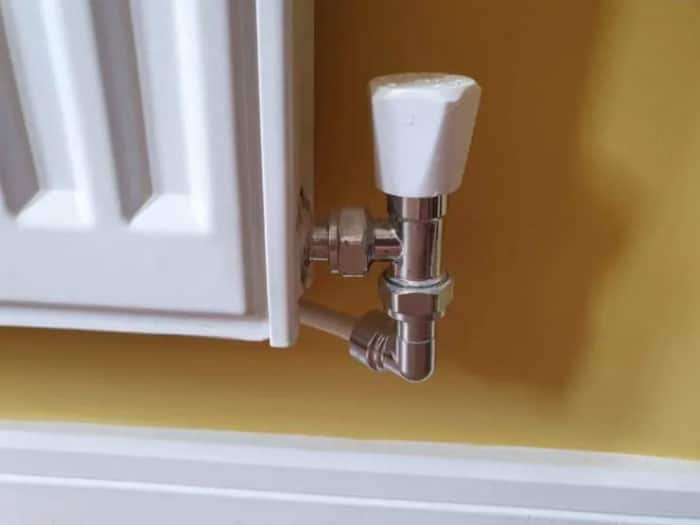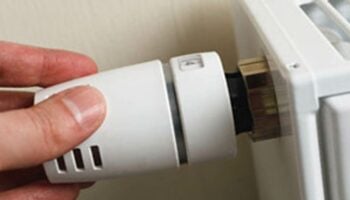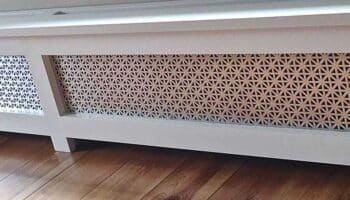We've independently reviewed this article to make sure it's as accurate as we can make it.
To find out more about our article creation and review process, check out our editorial guidelines.
If your home is heated with radiators, you may find times that you want to turn one or all of them off. There is no reason to heat an empty room, and turning off the radiator can conserve energy.

If you have radiators with broken or spinning knobs, you may not be able to turn your radiator off. Heater knobs and valves will eventually fail. You need an alternative method to turn off the flow of hot water through your radiator when they do.
Read on if you need to turn off a radiator with a broken or spinning knob.
Types of Radiator Valves
Not all radiators are the same, and older units generally have an on and off valve. Newer radiators, however, have thermostatic control valves that can control the level of heat in a room. The type of valves on your radiator unit will help you determine which kind you have and what you will need to do if you need to turn off your radiator.
No matter which type of these valves you are attempting to turn on or off, do not force them. Forcing a knob can damage the valve and potentially cause a leak. Instead, if the knob will not turn one way, try turning it in the opposite direction. If both of these measures fail, you have a bad valve.
Non-thermostatic Valves
Older radiators usually have only one valve. The non-thermostatic valves of these units either have two positions (on/ off) or they act like a spigot to control the water flow. If stuck in either position, your radiator may be unusable or overheat the room it is in.

You will find a non-thermostatic valve on the lower right or left side of the unit. On the other side will be a valve with a cap. This apparatus is called the lockshield valve and is an integral part of radiators with and without thermostats. The lockshield valve will completely isolate the radiator from the system when closed along with the control valve.
Under normal circumstances, a turn of your radiator’s knob to the right (clockwise) as far as it will go will turn off the flow of water to the radiator. However, if the knob spins freely, you may have a problem that requires turning off the flow of water to the radiator.
Thermostatic Valves
Thermostatic valves on radiators are usually found low on the left side of the radiator. They have numbered dials and allow you to adjust the level of heat they give off. The off position on this type of valve is “0” on the dial. However, if your knob spins past the zero or spins freely, then how to turn the unit off becomes extremely important.

Newer systems have a second valve; in addition, that does not have a dial with numbers. Its function is the same as on older style radiators and is used to close the system entirely from the boiler. Again, you turn this knob clockwise until it stops. If it is broken or spins, you need to replace or repair it.
There are several reasons you might need to isolate a radiator from the system. Radiators are made of steel, will often rust, and can leak. Turning off the water leading to the radiator will allow you to remove it and repair or replace the unit. Broken or spinning knobs are also why you may want to isolate the radiator from the system while the offending knob is repaired or replaced.
Turning off a Radiator with a Broken or Spinning Knob
Okay, now you should know the type of valve you are contending with. One is to adjust the temperature, while the other is to stop the water supply to the radiator. While, in essence, the two valves do the same thing, the lockshield valve is the main water supply line, and your first go to if your radiator has a broken or spinning knob.
Lockshield valves
Water from the boiler enters your radiator through the lockshield valve. Therefore, if you want to stop water flow to your radiator, you must unlock this valve to turn off the water that supplies the radiator.
Suppose the other valve of the radiator fails in some way. In that case, you will need to close the lockshield valve to isolate the radiator from the system. Once off, you can then drain the radiator, if necessary, and repair or replace the faulty valve.
The lockshield valve on your radiator serves two purposes. First, it is integral to the complete heating system and balances the system’s pressure. Second, once the water pressure is balanced, the valve is locked into position. As a result, this valve is rarely used unless you have a problem and isolate the radiator from the rest of the system.
How to turn off the water with the Lock Shield valve
A lockshield valve may have a knob that will turn the valve to the off position. Alternatively, it may have a cap you need to remove and a screw that you must turn to the off position. You need to turn the knob to the right (clockwise) for either type of valve until it stops. When you have repaired your radiator’s broken, spinning knob, you will need to reopen the lockshield valve to allow the hot water from the boiler to enter the radiator.
Is my Knob or my Valve bad?
Knobs often have a set screw that holds them in place. If this screw gets loose, falls out, or wears out, it may not hold the knob in position, causing it to spin freely and do nothing. Therefore, when determining if your radiator has a broken knob or valve, check whether the knob is working. Checking it first may save you a lot of time and may be all you need to do to be able to turn your radiator off.
To determine if you have a bad knob or valve, remove the knob and gently turn the valve with a pair of pliers until it stops. If the radiator gets cold, you have a stripped knob. However, if the valve stem does not stop when you turn it, you have a bad valve and need to replace it. Now that you know how to stop the flow of water to the radiator, you can cool it down so that you can replace a faulty valve if necessary or fix a spinning knob.
Can you turn your radiator off now?
Now that you know how to turn off a radiator with a broken or spinning knob, you can gather the tools and parts you need and fix the damaged or spinning handle. However, if you are not confident in performing this task, a professional will be glad to fix it for you, at a cost, of course.
Working with any appliance that produces heat can be dangerous. In addition, when you are working with heated parts and water, you need to be very careful not to be burnt. Take your time to repair your radiator valve, and allow it and the water to cool before proceeding with your task.
Conclusion
I hope the advice in this article has helped you today!
If you’re still stuck, feel free to shoot us a message via the contact page.
Please also consider signing up to our mailing list, where we share money-saving tips for your home and appliances.
Thank you for reading, and have a great day!







